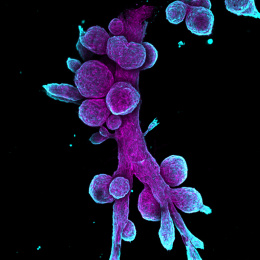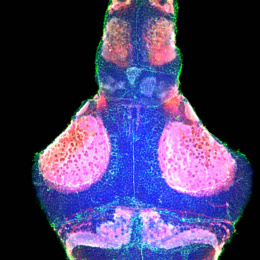Tissue Folding Origami
Tissue Folding Origami
Mary Ann Collins
MIT Department of Biology
The art of paper folding, origami, transforms two-dimensional sheets of paper into complex three-dimensional objects. Much like origami, tissues undergo extensive remodeling that transform an embryo from a simple collection of cells into specific organs, each with a characteristic structure and function. Such events are driven by mechanical forces that are generated by individual cells which then collectively bend tissues into different shapes. This image shows “tissue origami” in action- cells in the center of the tissue sheet constrict inward and pull opposite sides of the tissue together, resulting in a newly-formed fold down the middle.
This image was taken to visualize how the mechanical connections between cells are rearranged during the folding process. Within a tissue sheet, each cell (labeled by its nucleus) is physically linked to neighboring cells via intercellular junctions (labeled in orange). As the tissue folds, cells on opposite side of the tissue come into contact with one another. New cell-cell contacts between these previously separated cells must be made in order to maintain mechanical integrity of the tissue. From such images, we can learn how the collective behavior of many cells contribute to the overall reshaping of the tissue.






